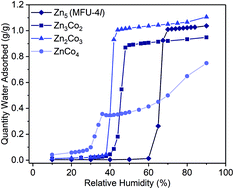当前位置:
X-MOL 学术
›
Chem. Sci.
›
论文详情
Our official English website, www.x-mol.net, welcomes your
feedback! (Note: you will need to create a separate account there.)
Precise control of pore hydrophilicity enabled by post-synthetic cation exchange in metal–organic frameworks†
Chemical Science ( IF 7.6 ) Pub Date : 2018-03-21 00:00:00 , DOI: 10.1039/c8sc00112j Ashley M. Wright 1, 2, 3, 4 , Adam J. Rieth 1, 2, 3, 4 , Sungwoo Yang 2, 3, 4, 5 , Evelyn N. Wang 2, 3, 4, 5 , Mircea Dincă 1, 2, 3, 4
Chemical Science ( IF 7.6 ) Pub Date : 2018-03-21 00:00:00 , DOI: 10.1039/c8sc00112j Ashley M. Wright 1, 2, 3, 4 , Adam J. Rieth 1, 2, 3, 4 , Sungwoo Yang 2, 3, 4, 5 , Evelyn N. Wang 2, 3, 4, 5 , Mircea Dincă 1, 2, 3, 4
Affiliation

|
The ability to control the relative humidity at which water uptake occurs in a given adsorbent is advantageous, making that material applicable to a variety of different applications. Here, we show that cation exchange in a metal–organic framework allows precise control over the humidity onset of the water uptake step. Controlled incorporation of cobalt in place of zinc produces open metal sites into the cubic triazolate framework MFU-4l, and thereby provides access to materials with uptake steps over a 30% relative humidity range. Notably, the MFU-4l framework has an extremely high water adsorption capacity of 1.05 g g−1, amongst the highest known for porous materials. The total water capacity is independent of the cobalt loading, showing that cation exchange is a viable route to increase the hydrophilicity of metal–organic frameworks without sacrificing capacity.
中文翻译:

在金属-有机骨架中通过合成后阳离子交换实现对孔亲水性的精确控制†
控制在给定吸附剂中发生吸水的相对湿度的能力是有利的,这使得该材料可应用于多种不同的应用。在这里,我们证明了金属有机框架中的阳离子交换可以精确控制吸水步骤的湿度。钴代替锌的受控掺入会在立方三唑酸酯骨架MFU-4 l中产生开放的金属位点,从而使物料进入步骤的相对湿度超过30%。值得注意的是,MFU-4 l骨架具有1.05 gg -1的极高吸水量,是已知的多孔材料中最高的。总水容量与钴负载量无关,表明阳离子交换是增加金属-有机骨架亲水性而不牺牲容量的可行途径。
更新日期:2018-03-21
中文翻译:

在金属-有机骨架中通过合成后阳离子交换实现对孔亲水性的精确控制†
控制在给定吸附剂中发生吸水的相对湿度的能力是有利的,这使得该材料可应用于多种不同的应用。在这里,我们证明了金属有机框架中的阳离子交换可以精确控制吸水步骤的湿度。钴代替锌的受控掺入会在立方三唑酸酯骨架MFU-4 l中产生开放的金属位点,从而使物料进入步骤的相对湿度超过30%。值得注意的是,MFU-4 l骨架具有1.05 gg -1的极高吸水量,是已知的多孔材料中最高的。总水容量与钴负载量无关,表明阳离子交换是增加金属-有机骨架亲水性而不牺牲容量的可行途径。











































 京公网安备 11010802027423号
京公网安备 11010802027423号